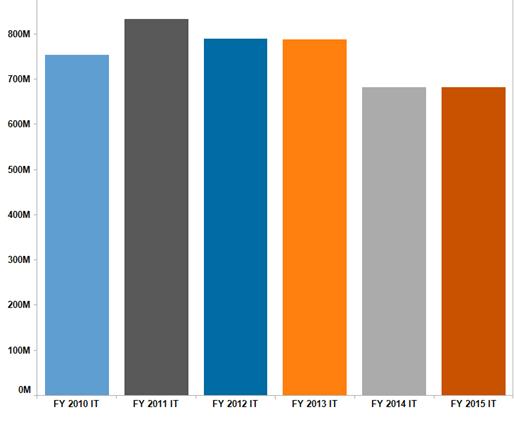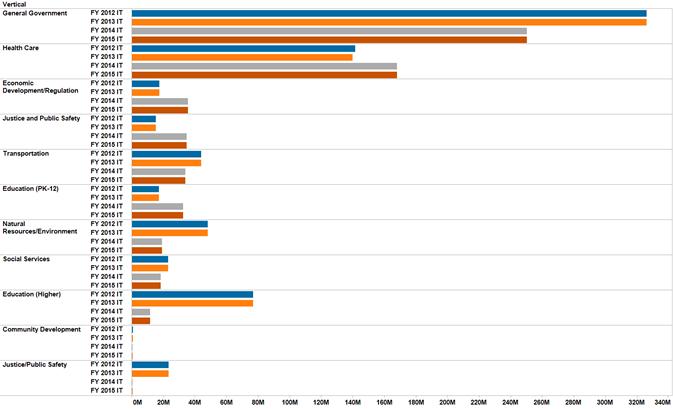North Carolina’s road to long-term success
Published: May 31, 2013
BudgetCommunity DevelopmentEconomic Development/RegulationEducation (Higher)Education (Primary/Secondary)General Government ServicesGovernorHealth CareJustice/Public Safety & Homeland SecurityNatural Resources/EnvironmentPublic FinanceSocial ServicesTransportation
This year, North Carolina Governor Pat McCrory made it clear that the state’s reliance on quick fixes is over and that his goal is to begin focusing on long-term reparations to ensure the state’s ability to provide for its citizens.
The below graph provides a visual representation of North Carolina’s budget from FY 2010 through FY 2015.

Governor McCrory’s major focus areas include increasing the State Repair and Renovation Fund to launch a 25-year plan to replace and upgrade aging infrastructure. He is also looking to increase the Information Technology Systems Reserve in an effort to fund high-priority IT projects taking place throughout government agencies. These are quite ambitious projects given the state is only increasing the overall budget by 3.6 percent in the first year, and while the governor has indeed asked for a significant increase in the IT Systems Reserve, it comes at the cost of the Office of Information Technology. While the IT Initiative Reserve is set to increase by nearly $35 million between FY 2013 and FY 2014, the Office of Information Technology is losing more than $39 million. Therefore, technology dollars are more so reshuffling existing resources, and there will actually be less money available in the next few years for IT projects.

The majority of these IT funds will be spread throughout government operations with basic upgrades to communications and data processing, LAN support, hardware and software upgrades being budgeted for nearly every department. These projects make up the majority of IT spending, with a few smaller projects such as telephone upgrades and the purchase of video transmission equipment being implemented in specific departments. The next two years are likely to be fairly quiet on the technology front with routine upgrades and replacements taking place while the government settles into the new structure and departments come to rely more on the IT reserve than the Office of IT.
Overall, the structure of the state’s departments has remained unchanged over the past few years. The one significant exception is the dissolution of the states’ Departments of Correction and Crime Control and Public Safety, and the advent of the new Department of Public Safety. Funding for the new department remained consistent with the funding levels of its predecessors, and no major initiatives, IT or otherwise, are planned for the next two years.
Unfortunately, not all budget changes involved a simple reshuffling; some departments lost significant amounts of money. The biggest loser was the state’s Department of Commerce, which lost more than $3 billion, followed by the Department of Transportation’s $1.5 billion loss, though it is likely that at least some of that loss was transferred to the Repair and Renovation Fund.
The Department of Public Instruction lost $82.5 million, despite the much-touted focus on state schools. That said, there was a billion-dollar increase in the state’s public schools funding, and another million was added for state colleges and universities. These increases, coupled with a nearly $80 million boost in funding for community colleges, actually increases the overall education budget by more than a billion dollars. The amount of money to be spent on IT is depicted below in the vertical breakdown of IT spending for FY 2013 through FY 2015.

Analyst’s Take
The small increase in the state’s overall budget means that most departments will maintain the status quo for the next two years. Few costly initiatives are planned, and as the governor stated, the next few years will be used to set the stage for long-term growth.
While the overall budget remains fairly steady over the next two years, the IT budget has dropped significantly, which will likely have an impact on spending for the next few years at least, especially for those interested in the community development, general government and natural resources verticals. As expected, health care continues to be a growth area as well as economic development and regulation, which will likely be heavily focused on regulation and compliance.
Vendors should take the chance to begin networking with employees who deal with the strengthened IT Initiative Reserve and work to help departments upgrade their current systems and plan for new projects. Vendors interested in current projects should focus on several divisions within the department of Health and Human Services, especially the Division of Mental Health, Developmental Disabilities and Substance Abuse Services, and the Divisions of Public Health and Social Services, along with the education departments mentioned above.
Vendors interested in finding out more about North Carolina should check out Deltek’s state profile application.